
Masjid-i-Jehan-Numa, commonly known as the Jama Masjid of Delhi, is one of the largest mosques in India.

Kalbadevi is an old neighbourhood in Mumbai (Bombay), India. It is named after Goddess Kalbadevi, the Hindu Goddess. Kalbadevi area is one of the busiest areas during peak hours. The area has mostly traders in watches, bicycles, steel utensils, etc.

Masjid is a railway station in the Masjid Bunder area of South Mumbai on the Central and Harbour lines of the Mumbai Suburban Railway. It is the penultimate stop for all trains on those lines in the "up" direction. It was opened on 20th September 1875. The station is named after a masjid (mosque) annexed to this Suburban Railway Station. That is SAT TAD Masjid. Contrary to popular belief a synagogue, is never called a masjid. This Railway station is in Mandvi Section.
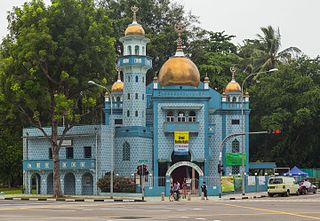
Masjid Malabar or Malabar Muslim Jama-Ath Mosque, also known as Golden Dome Mosque; is Singapore's only Malabar Muslim mosque. The mosque is located at the junction of Victoria Street and Jalan Sultan in the Kampong Glam district, in the Rochor Planning Area within the Central Area. The mosque is built on the Sultan Mosque style with traditional blue and white lapis lazuli tile facade. The mosque was nicknamed as little cousin of the Sultan Mosque, because of similar golden domes.

Jama Masjid is a mosque in Srinagar, Jammu and Kashmir, India. Situated at Nowhatta in the Old City, the Mosque was commissioned by Sultan Sikandar in 1394 CE and completed in 1402 CE, at the behest of Mir Mohammad Hamadani, son of Mir Sayyid Ali Hamadani, and is regarded as one of the most important mosques in Kashmir. The mosque is located downtown, a central zone in the religio-political life in Srinagar. Thronged by Muslims every Friday, it is a prime tourist attractions of Srinagar.

The holiest sites in Islam are predominantly located in the Arabian Peninsula and the Levant. While the significance of most places typically varies depending on the Islamic sect, there is a consensus across all mainstream branches of the religion that affirms three cities as having the highest degree of holiness, in descending order: Mecca, Medina, and Jerusalem. Mecca's Al-Masjid al-Haram, Al-Masjid an-Nabawi in Medina and Al-Masjid al-Aqsa in Jerusalem are all revered by Muslims as sites of great importance.

The Taj-ul-Masajid or Tāj-ul-Masjid, is a mosque situated in Bhopal, Madhya Pradesh, India. It is the largest mosque in India and one of the largest mosques in the world.
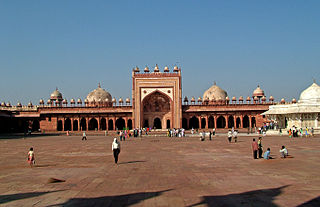
The Jama Masjid is a 16th-century congregational mosque in the UNESCO World Heritage Site of Fatehpur Sikri, located in Uttar Pradesh, India. It was built by Mughal emperor Akbar, and was the largest mosque in the empire at the time of construction. The Jama Masjid's design drew from earlier mosques built by various pre-Mughal sultanates, and served as an important precedent in subsequent Mughal architecture.
Hallaur or Hallor village is located in Domariyaganj Tehsil of Siddharthnagar district in Uttar Pradesh, India. Domariyaganj is the nearest town to Hallaur village.

The Fatehpuri Mosque is a 17th-century mosque in India located at the western end of the oldest street of Chandni Chowk, in the Old Delhi neighbourhood of Delhi, India. It is opposite the Red Fort on the opposite end of Chandni Chowk.

Both Sunni Muslims and Shia Muslims agree on the three Holiest sites in Islam being, respectively, the Masjid al-Haram, in Mecca; the Al-Masjid an-Nabawi, in Medina; and Al-Masjid al-Aqsa, in Jerusalem.

Jama Masjid or Jama Mosque or Jami Masjid or Badi Masjid, one of the largest Mosques in India, is a 15th-century mosque built by Hussain Shah Sharqi of the Jaunpur Sultanate in Jaunpur, Uttar Pradesh, India. It is one of the chief tourist attractions in Jaunpur. The mosque is 2.2 km north-northeast of Jaunpur, 7.3 km northwest of Zafarābād, 16.8 km north-northeast of Mariāhū, 26.3 km west-northwest of Kirākat. It is 1 km from the Atala mosque.
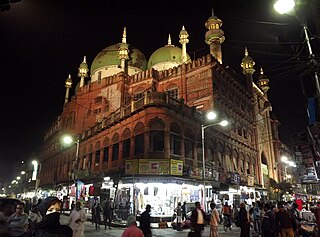
The Nakhoda Musjid is the principal mosque of Kolkata, India, in the Chitpur area of the Burrabazar business district in Central Kolkata, at the intersection of Zakaria Street and Rabindra Sarani.
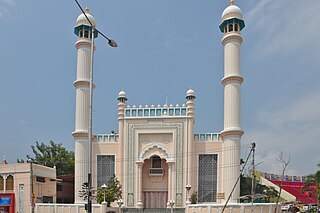
Masjid-i Jahān-Numā, commonly known as the Palayam Juma Masjid of Trivandrum, is the principal mosque of Trivandrum in Kerala, India. It is a Jama Masjid.

Jama Masjid, also known as Jumah Mosque or Jami' Masjid, is a mosque in Ahmedabad, Gujarat, India. It was built in 1424 during the reign of Ahmad Shah I. The inscription on the central mihrab commemorates the inauguration of the mosque on the 1st Safar A.H. 827 or January 4, 1424 A.D. by Sultan Ahmad Shah I. The mosque lies in the old walled city, and it is situated outside Bhadra Fort area. The old walled city is divided into separate quarters or pols, and the Jami' Masjid is found on the Gandhi Road. Along the south side of the road, the mosque is a short distance beyond the Teen Darwaza or Tripolia Gate.
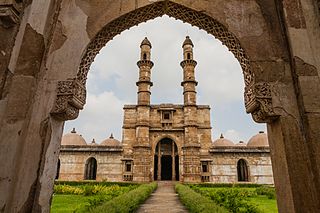
Jami Masjid in Champaner, Gujarat state, western India, is part of the Champaner-Pavagadh Archaeological Park, a UNESCO World Heritage Site, and is among the 114 monuments there which are listed by the Baroda Heritage Trust. It is located about 150 feet (46 m) east of the city walls (Jahdnpandh), near the east gate.

There are eleven different types of buildings at the UNESCO-protected Champaner-Pavagadh Archaeological Park in Gujarat, India, including mosques, temples, granaries, tombs, wells, walls, and terraces. The monuments are situated at the foot of and around the Pavagadh Hill. The Baroda Heritage Trust lists 114 monuments in the area, of which only 39 are maintained by the Archaeological Survey of India, due to limited funding. The Forest Department owns 94% of the land here, while the temple trusts and other sectarian establishments provide facilities for boarding and lodging to pilgrims and tourists. On the southern side near the foot of the hill some dilapidated houses and the foundations of Jain temples can also be seen.

Jama Masjid, Bhilai is one of the largest mosques in Chhattisgarh, India, and also in Asia with a capacity to accommodate more than 3000 worshippers at a time. It is the first mosque in the world to be built in the shape of the word "Ya Allah" in Arabic script. It took three years for the construction of the mosque which was completed in 1967.

Jama Masjid, Pilibhit was constructed by Hafiz Rahmat Khan Barech in 1769. It was modelled on the Jama Masjid Delhi. The cost of the construction of Jama Masjid in Pilibhit was Rs. 3 lakhs.
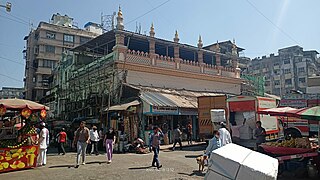
Sat Tad Masjid is a mosque situated in Mandvi division, Mumbai, India. The mosque abuts the Masjid railway station, lending the station its name.




















